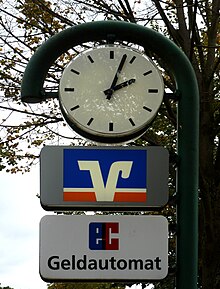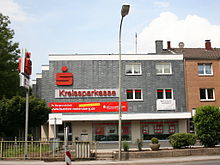Banking in Germany
You can help expand this article with text translated from the corresponding article in German. (November 2023) Click [show] for important translation instructions.
|
This article needs additional citations for verification. (December 2017) |

Banking in Germany is a highly leveraged industry, as its average
GDP or 167% of its national debt.[1]
History
From the 15th century, banking families such as
Berenberg family, and is the world's oldest or second oldest bank
, depending on the exact definition.
Market overview


Germany has
universal banking
.
The private customer mostly has to choose between three kinds of banks (German "three pillar system"):
- private banks (including direct banks): the largest ones are Deutsche Bank, Postbank (acquired by Deutsche Bank), Unicredit Bank AG (HypoVereinsbank), Commerzbank and Dresdner Bank (which was acquired by Commerzbank in 2008) – they cooperate together as the Cash Group
- cooperative banks: see German Cooperative Financial Group
- Sparkassen and Landesbanken, see Sparkassen-Finanzgruppe
Private banks are found mostly in the cities, whereas cooperative and savings banks are almost everywhere and are often exclusive[clarification needed] in smaller villages.
Online payments are done mostly either with direct debit
(Lastschrift) or with a credit card.
Most banks offer a free main account (Girokonto) as long as the customer deposits a minimum amount regularly (over €1000 in income each month).
See also
References
- ^ Norris, Floyd (10 October 2008). "The World's Banks Could Prove Too Big to Fail – or to Rescue". Nytimes.com. Retrieved 15 December 2017.
Further reading
- Born, Karl Erich. International Banking in the 19th and 20th Centuries (St Martin's, 1983) online
- Cable, J. "Capital Market Information and Industrial Performance: The Role of West German Banks" (1985) 95 Economic Journal, p. 118+
![]() Media related to Banking in Germany at Wikimedia Commons
Media related to Banking in Germany at Wikimedia Commons
